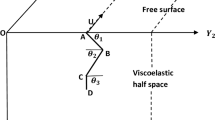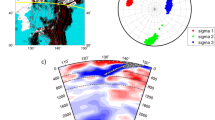Abstract
The three-dimensional shapes of tectonic plates that sink into the Earth’s mantle (slabs) are the starting point for a range of geoscience studies, from determining the forces driving the motion of tectonic plates, to potential seismic and tsunami hazards, to the sources of magmas beneath active volcanos. For many of these applications finite element methods are used to model the deformation or fluid flow, and therefore the input model parameters, such as feature geometries, temperature or viscosity, must be defined with respect to a smooth, continuous distance field around the slab. In this paper we present a framework for processing sparse and noisy seismic data (earthquake locations), defining the shape of the slab and computing a continuous distance function on a mesh with variable node spacing. Due to the inhomogeneous volumetric distribution of earthquakes within the slab and significant inaccuracies in the locations of earthquakes occurring hundreds of kilometers below the Earth’s surface, the seismicity data set is extremely noisy and incomplete. Therefore, the preprocessing is the major part of the framework consisting of several steps including a point based smoothing procedure, a powerful method to use other observational constraints on slab location (e.g., seismic tomography or geologic history) to extend of the slab shape beyond earthquake data set and continuous resampling using moving least squares method. For the preprocessed point data we introduce approaches for finding the three-dimensional boundary of the slab and a subdivision of the slab into quadric implicit polynomials. The resulting distance field is then compiled from distances to the piecewise continuous approximation of the slab and distances to slab boundary.
Similar content being viewed by others
References
Amenta, N., Bern, M.: Surface reconstruction by voronoi filtering. In: SCG ’98: Proceedings of the Fourteenth Annual Symposium on Computational Geometry, ACM Press, pp. 39–48 (1998)
Alexa, M., Behr, J., Cohen-Or, D., Fleishman, S., Levin, D., Silva, C.T.: Point set surfaces. In: Conference on Visualization. IEEE Comput. Soc. pp. 21–28 (2001)
Amenta, N., Choi, S., Kolluri, R.K.: The power crust. In 6th ACM Symposium on Solid Modeling and Applications. ACM Press, pp. 249–266 (2001)
Billen M.I., Gurnis M., Simons M.: Multiscale dynamics of the Tonga–Kermadec subduction zone. Geophys. J. Int. 153, 359–388 (2003)
Belyaev, A., Ohtake, Y.: A comparison of mesh smoothing methods. In: Israel-Korea Bi-National Conference on Geometric Modeling and Computer Graphics. Tel Aviv University, pp. 83–87 (2003)
Chiao, L.-Y.: Membrane Deformation rate and geometry of subducting slabs. Master’s thesis, University of Washington (1991)
Desbrun, M., Meyer, M., Schröder, P., Barr, A.H.: Implicit fairing of irregular meshes using diffusion and curvature flow. In: SIGGRAPH ’99 (1999), ACM Press/Addison-Wesley Publishing Co., pp. 317–324
Fleishman S., Drori I., Cohen-Or D.: Bilateral mesh denoising. ACM Trans. Graph. 22(3), 950–953 (2003)
Gärtner, B., Schönherr, S.: Smallest enclosing ellipses—an exact and generic implementation. Tech. Rep. B 98-05, Institut für Theoretische Informatik, ETH Zentrum Zürich / Institut für Informatik Freie Universität Berlin (1998)
Gudmundsson Ó., Sambridge M.: A regionalized upper mantle (RUM) seismic model. J. Geophys. Res. 103, 7121–7136 (1998)
Isacks B. L., Barazangi M.: Geometry of benioff zones: lateral segmentation and downwards bending of the subducted lithosphere. In; Island Arcs, Deep Sea Trenches and Back-arc Basins, vol. 1, pp. 99–114 (1977)
Jadamec M.A., Billen M.I.: Reconciling surface plate motions with rapid three- dimensional mantle flow around a slab edge. Nature 465, 338–341 (2010)
Jones T.R., Durand F., Desbrun M.: Non-iterative, feature-preserving mesh smoothing. ACM Trans. Graph. 22(3), 943–949 (2003)
Kobbelt, L., Campagna, S., Vorsatz, J., Seidel, H.-P.: Interactive multi-resolution modeling on arbitrary meshes. In: SIGGRAPH’98. ACM Press, pp. 105–114 (1998)
Lee, K.-W., Wang, W.-P.: Feature-preserving mesh denoising via bilateral normal filtering. In: 9th International Conference on Computer Aided Design and Computer Graphics. IEEE Comput. Soc., pp. 275–280 (2005)
Miller M.S., Gorbatov A., Kennett B.L.N.: Three-dimensional visualization of a near-vertical slab tear beneath the southern Mariana arc. Geochem. Geophys. Geosyst. 7, 6012 (2006)
Nothard S., McKenzie D., Haines J., Jackson J.: Gaussian curvature and the relationship between the shape and the deformation of the Tonga slab. Geophys. J. Int. 127, 311–327 (1996)
Ohtake Y., Belyaev A.G., Bogaevski I.: Mesh regularization and adaptive smoothing. Comput. Aided Des. 33(11), 789–800 (2001)
Ratchkovzki N.A., Hansen R.A.: New evidence for segmentation of the Alaska subduction zone. Bull. Seismol. Soc. Am. 92, 1754–1765 (2002)
Romanowicz B.: Global mantle tomography: progress status in the past 10 years. Ann. Rev. Earth Planet. Sci. 31, 303–328 (2003)
Syracuse, E.M., Abers, G.A.: Global compilation of variations in slab depth beneath arc volcanoes and implications. Geochem. Geophys. Geosyst. 7 (2006)
Sipkin, S.A., Person, W.J., Presgrave, B.W.: Earthquake bulletins and catalogs at the usgs national earthquake information center. In: Iris News Letter, vol. 1, pp. 2–4 (2000)
Sun X., Rosin P., Martin R., Langbein F.: Fast and effective feature-preserving mesh denoising. IEEE Trans. Vis. Comput. Graph. 13(5), 925–938 (2007)
Sun, X., Rosin, P.L., Martin, R.R., Langbein, F.C.: Random walks for mesh denoising. In: Symposium on Solid and Physical Modeling, ACM, pp. 11–22 (2007)
Tackley P.J.: Mantle convection and plate tectonics: toward an integrated physical and chemical theory. Science 288, 2002–2007 (2000)
Taubin, G.: A signal processing approach to fair surface design. In: ACM SIGGRAPH, ACM Press, pp. 351–358 (1995)
Vančo, M., Brunnett, G.: Geometric preprocessing of noisy point sets: an experimental study. Computing 79, (2007) [Special issue on Geometric Modeling]
Vančo, M., Brunnett, G., Schreiber, T.: A hashing strategy for efficient k-nearest neighbors computation. In: International Conference on Computer Graphics, IEEE Comput. Soc., pp. 120–127 (1999)
van der Hist R., Engdahl R., Spakman W., Nolet G.: Tomographic imaging of subducted lithosphere below northwest Pacific island arcs. Nature 353, 37–43 (1991)
Vančo M., Hamann B., Brunnett G.: Surface reconstruction from unorganized point data with quadrics. Comput. Graph. Forum 27(6), 1593–1606 (2008)
Vassiliou M.S.B.H.H., Raefsky A.: The distribution of earthquakes with depth and stress in subducting slabs. J. Geodyn. 1, 11–28 (1984)
Welzl, E.: Smallest enclosing disks (balls and ellipsoids). In: New Results and New Trends in Computer Science, LNCS. Springer, Berlin. (1991)
wei Zhoua H.: Observations on earthquake stress axes and seismic morphology of deep slabs. Geophys. J. Int. 103(2), 377–401 (1990)
Zhang H., Thurber C., Shelly D., Ide S., Beroza G.C., Hasegawa A.: High-resolution subducting slab structure beneath northern Honshu, Japan, revealed by double-difference tomography. AGU Fall Meet. Abstr. 32(4), 361–364 (2003)
Author information
Authors and Affiliations
Corresponding author
Additional information
Communicated by Gabriel Wittum.
Rights and permissions
About this article
Cite this article
Vančo, M., Hamann, B., Kreylos, O. et al. Distance field computation for geological slab surface data sets. Comput. Visual Sci. 14, 143–156 (2011). https://doi.org/10.1007/s00791-012-0169-9
Received:
Accepted:
Published:
Issue Date:
DOI: https://doi.org/10.1007/s00791-012-0169-9




